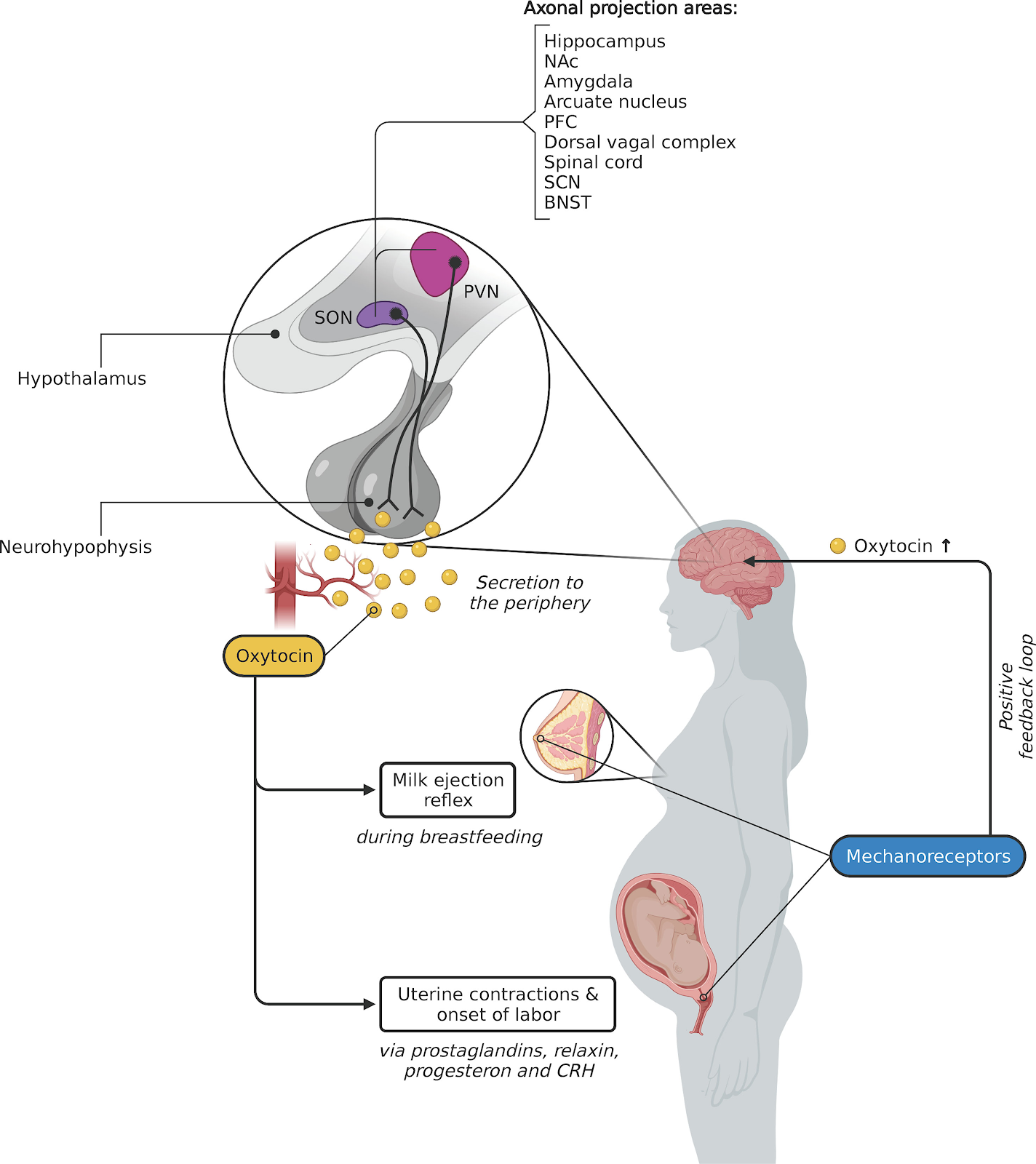Push it to the limit – and I’m talking about labor, not a song from the 2007 Disney Channel movie “Jump In!” from our childhoods. Pitocin is a synthetic form of the hormone oxytocin that is often dubbed “the love hormone” due to its release during sexual arousal and intimacy. However, oxytocin has crucial functions which include stimulating contraction of the myometrium to start labor, and effects on lactation such as the movement of breast milk from ducts to nipple. Oxytocin is a peptide hormone that is synthesized in the hypothalamus and released from the posterior pituitary. Its release acts in a positive feedback loop to continually strengthen contractions in labor. Sometimes, there are clinical implications that call for administering synthetic oxytocin, or Pitocin. Pitocin is used to induce uterine contractions in uterine inertia, which is when the uterus doesn’t contract strongly/rapidly enough to progress labor. Another use is a patient with preeclampsia or gestational diabetes who needs to be induced preterm due to medical complications. Third is in the management of second-term abortions. Pitocin can also be used to control late-stage uterine contractions and manage postpartum hemorrhage by preventing blood loss.
Stimulation of the uterus by oxytocin is not a new phenomenon (offspring have been produced forever), but the mechanisms by which oxytocin does its job is still being studied. The myometrium has oxytocin receptors, which are a type of G-protein coupled receptor. Binding of oxytocin causes activation of the GPCR and a cascade of enzyme/molecule binding including phospholipase C-β, phosphoinositide-bis-phosphate, inositol-trisphosphate, and diacylglycerol. These compounds cause the release of Ca2+ from storage in places like the sarcoplasmic reticulum. Calcium release stimulates Ca2+-dependent calmodulin as well as myosin light chain kinase (MLCK) which causes smooth muscle contractions. This is the generally accepted pathway by which oxytocin works, but the pathway is likely more complicated.
While the use of synthetic hormones in medicine has been
lifesaving technology (e.g., levothyroxine), it does not come without ethical
implications. One main ethical dilemma surrounds the use of Pitocin to induce contractions
in patients getting an abortion. Many people against abortion would object to
the use of a synthetic hormone to induce birth of a fetus that would not be viable
outside of the uterus. Another ethical complication is the use of synthetic
hormones in medicine at all. This leads into complex ideas such as gender-confirming
hormone treatments or synthetics like ethinyl estradiol in contraceptives.
Copy and paste link for a surprise: https://www.youtube.com/watch?v=A3-JA49q-0o&feature=share&utm_source=EJGixIgBCJiu2KjB4oSJEQ
Arrowsmith, S. & Wray, S. (2014). Oxytocin: Its mechanism of action and receptor signalling in the Myometrium. Journal of Neuroendocrinology, 26, 356-369. doi: 10.1111/jne.12154.
United States Food and Drug Administration. (n.d). Pitocin®
(Oxytocin Injection, USP) Synthetic [Fact Sheet]. https://www.accessdata.fda.gov/drugsatfda_docs/label/2014/018261s031lbl.pdf.
Walter, M.H., Abele, H. & Plappert, C.F. (2021). The role of oxytocin and the effect of stress during childbirth: Neurobiological basics and implications for mother and child. Frontiers in Endocrinology, 12(742236), 1-10. https://doi.org/10.3389/fendo.2021.742236.
Watson, S. (2021, 20 July). Oxytocin: The love hormone. Harvard
Health Publishing. https://www.health.harvard.edu/mind-and-mood/oxytocin-the-love-hormone.


No comments:
Post a Comment